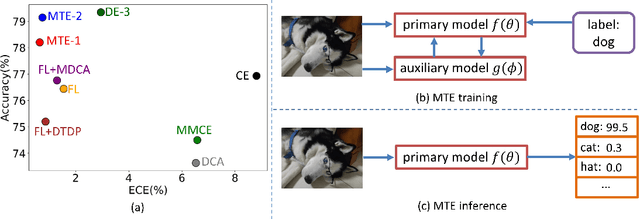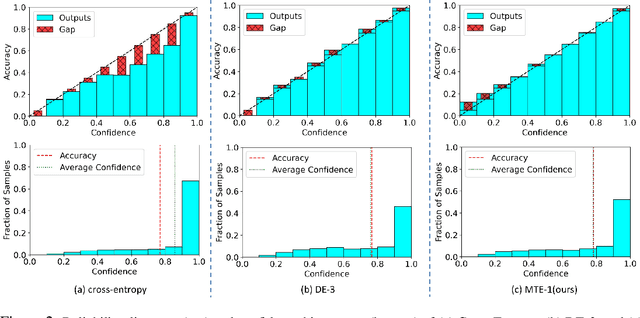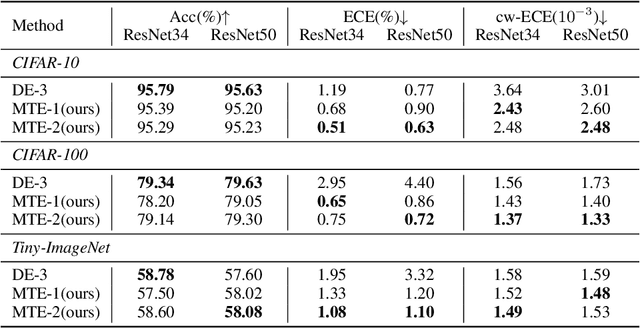Jun Zhu
Tsinghua University
Aligning Diffusion Behaviors with Q-functions for Efficient Continuous Control
Jul 12, 2024



Abstract:Drawing upon recent advances in language model alignment, we formulate offline Reinforcement Learning as a two-stage optimization problem: First pretraining expressive generative policies on reward-free behavior datasets, then fine-tuning these policies to align with task-specific annotations like Q-values. This strategy allows us to leverage abundant and diverse behavior data to enhance generalization and enable rapid adaptation to downstream tasks using minimal annotations. In particular, we introduce Efficient Diffusion Alignment (EDA) for solving continuous control problems. EDA utilizes diffusion models for behavior modeling. However, unlike previous approaches, we represent diffusion policies as the derivative of a scalar neural network with respect to action inputs. This representation is critical because it enables direct density calculation for diffusion models, making them compatible with existing LLM alignment theories. During policy fine-tuning, we extend preference-based alignment methods like Direct Preference Optimization (DPO) to align diffusion behaviors with continuous Q-functions. Our evaluation on the D4RL benchmark shows that EDA exceeds all baseline methods in overall performance. Notably, EDA maintains about 95\% of performance and still outperforms several baselines given only 1\% of Q-labelled data during fine-tuning.
T2VSafetyBench: Evaluating the Safety of Text-to-Video Generative Models
Jul 08, 2024



Abstract:The recent development of Sora leads to a new era in text-to-video (T2V) generation. Along with this comes the rising concern about its security risks. The generated videos may contain illegal or unethical content, and there is a lack of comprehensive quantitative understanding of their safety, posing a challenge to their reliability and practical deployment. Previous evaluations primarily focus on the quality of video generation. While some evaluations of text-to-image models have considered safety, they cover fewer aspects and do not address the unique temporal risk inherent in video generation. To bridge this research gap, we introduce T2VSafetyBench, a new benchmark designed for conducting safety-critical assessments of text-to-video models. We define 12 critical aspects of video generation safety and construct a malicious prompt dataset using LLMs and jailbreaking prompt attacks. Based on our evaluation results, we draw several important findings, including: 1) no single model excels in all aspects, with different models showing various strengths; 2) the correlation between GPT-4 assessments and manual reviews is generally high; 3) there is a trade-off between the usability and safety of text-to-video generative models. This indicates that as the field of video generation rapidly advances, safety risks are set to surge, highlighting the urgency of prioritizing video safety. We hope that T2VSafetyBench can provide insights for better understanding the safety of video generation in the era of generative AI.
HiDe-PET: Continual Learning via Hierarchical Decomposition of Parameter-Efficient Tuning
Jul 07, 2024Abstract:The deployment of pre-trained models (PTMs) has greatly advanced the field of continual learning (CL), enabling positive knowledge transfer and resilience to catastrophic forgetting. To sustain these advantages for sequentially arriving tasks, a promising direction involves keeping the pre-trained backbone frozen while employing parameter-efficient tuning (PET) techniques to instruct representation learning. Despite the popularity of Prompt-based PET for CL, its empirical design often leads to sub-optimal performance in our evaluation of different PTMs and target tasks. To this end, we propose a unified framework for CL with PTMs and PET that provides both theoretical and empirical advancements. We first perform an in-depth theoretical analysis of the CL objective in a pre-training context, decomposing it into hierarchical components namely within-task prediction, task-identity inference and task-adaptive prediction. We then present Hierarchical Decomposition PET (HiDe-PET), an innovative approach that explicitly optimizes the decomposed objective through incorporating task-specific and task-shared knowledge via mainstream PET techniques along with efficient recovery of pre-trained representations. Leveraging this framework, we delve into the distinct impacts of implementation strategy, PET technique and PET architecture, as well as adaptive knowledge accumulation amidst pronounced distribution changes. Finally, across various CL scenarios, our approach demonstrates remarkably superior performance over a broad spectrum of recent strong baselines.
Identifying and Solving Conditional Image Leakage in Image-to-Video Diffusion Model
Jun 22, 2024



Abstract:Diffusion models have obtained substantial progress in image-to-video (I2V) generation. However, such models are not fully understood. In this paper, we report a significant but previously overlooked issue in I2V diffusion models (I2V-DMs), namely, conditional image leakage. I2V-DMs tend to over-rely on the conditional image at large time steps, neglecting the crucial task of predicting the clean video from noisy inputs, which results in videos lacking dynamic and vivid motion. We further address this challenge from both inference and training aspects by presenting plug-and-play strategies accordingly. First, we introduce a training-free inference strategy that starts the generation process from an earlier time step to avoid the unreliable late-time steps of I2V-DMs, as well as an initial noise distribution with optimal analytic expressions (Analytic-Init) by minimizing the KL divergence between it and the actual marginal distribution to effectively bridge the training-inference gap. Second, to mitigate conditional image leakage during training, we design a time-dependent noise distribution for the conditional image, which favors high noise levels at large time steps to sufficiently interfere with the conditional image. We validate these strategies on various I2V-DMs using our collected open-domain image benchmark and the UCF101 dataset. Extensive results demonstrate that our methods outperform baselines by producing videos with more dynamic and natural motion without compromising image alignment and temporal consistency. The project page: \url{https://cond-image-leak.github.io/}.
Benchmarking Trustworthiness of Multimodal Large Language Models: A Comprehensive Study
Jun 11, 2024



Abstract:Despite the superior capabilities of Multimodal Large Language Models (MLLMs) across diverse tasks, they still face significant trustworthiness challenges. Yet, current literature on the assessment of trustworthy MLLMs remains limited, lacking a holistic evaluation to offer thorough insights into future improvements. In this work, we establish MultiTrust, the first comprehensive and unified benchmark on the trustworthiness of MLLMs across five primary aspects: truthfulness, safety, robustness, fairness, and privacy. Our benchmark employs a rigorous evaluation strategy that addresses both multimodal risks and cross-modal impacts, encompassing 32 diverse tasks with self-curated datasets. Extensive experiments with 21 modern MLLMs reveal some previously unexplored trustworthiness issues and risks, highlighting the complexities introduced by the multimodality and underscoring the necessity for advanced methodologies to enhance their reliability. For instance, typical proprietary models still struggle with the perception of visually confusing images and are vulnerable to multimodal jailbreaking and adversarial attacks; MLLMs are more inclined to disclose privacy in text and reveal ideological and cultural biases even when paired with irrelevant images in inference, indicating that the multimodality amplifies the internal risks from base LLMs. Additionally, we release a scalable toolbox for standardized trustworthiness research, aiming to facilitate future advancements in this important field. Code and resources are publicly available at: https://multi-trust.github.io/.
Freeplane: Unlocking Free Lunch in Triplane-Based Sparse-View Reconstruction Models
Jun 02, 2024Abstract:Creating 3D assets from single-view images is a complex task that demands a deep understanding of the world. Recently, feed-forward 3D generative models have made significant progress by training large reconstruction models on extensive 3D datasets, with triplanes being the preferred 3D geometry representation. However, effectively utilizing the geometric priors of triplanes, while minimizing artifacts caused by generated inconsistent multi-view images, remains a challenge. In this work, we present \textbf{Fre}quency modulat\textbf{e}d tri\textbf{plane} (\textbf{Freeplane}), a simple yet effective method to improve the generation quality of feed-forward models without additional training. We first analyze the role of triplanes in feed-forward methods and find that the inconsistent multi-view images introduce high-frequency artifacts on triplanes, leading to low-quality 3D meshes. Based on this observation, we propose strategically filtering triplane features and combining triplanes before and after filtering to produce high-quality textured meshes. These techniques incur no additional cost and can be seamlessly integrated into pre-trained feed-forward models to enhance their robustness against the inconsistency of generated multi-view images. Both qualitative and quantitative results demonstrate that our method improves the performance of feed-forward models by simply modulating triplanes. All you need is to modulate the triplanes during inference.
Fourier Controller Networks for Real-Time Decision-Making in Embodied Learning
May 30, 2024Abstract:Reinforcement learning is able to obtain generalized low-level robot policies on diverse robotics datasets in embodied learning scenarios, and Transformer has been widely used to model time-varying features. However, it still suffers from the issues of low data efficiency and high inference latency. In this paper, we propose to investigate the task from a new perspective of the frequency domain. We first observe that the energy density in the frequency domain of a robot's trajectory is mainly concentrated in the low-frequency part. Then, we present the Fourier Controller Network (FCNet), a new network that utilizes the Short-Time Fourier Transform (STFT) to extract and encode time-varying features through frequency domain interpolation. We further achieve parallel training and efficient recurrent inference by using FFT and Sliding DFT methods in the model architecture for real-time decision-making. Comprehensive analyses in both simulated (e.g., D4RL) and real-world environments (e.g., robot locomotion) demonstrate FCNet's substantial efficiency and effectiveness over existing methods such as Transformer, e.g., FCNet outperforms Transformer on multi-environmental robotics datasets of all types of sizes (from 1.9M to 120M). The project page and code can be found https://thkkk.github.io/fcnet.
Accurate and Reliable Predictions with Mutual-Transport Ensemble
May 30, 2024



Abstract:Deep Neural Networks (DNNs) have achieved remarkable success in a variety of tasks, especially when it comes to prediction accuracy. However, in complex real-world scenarios, particularly in safety-critical applications, high accuracy alone is not enough. Reliable uncertainty estimates are crucial. Modern DNNs, often trained with cross-entropy loss, tend to be overconfident, especially with ambiguous samples. To improve uncertainty calibration, many techniques have been developed, but they often compromise prediction accuracy. To tackle this challenge, we propose the ``mutual-transport ensemble'' (MTE). This approach introduces a co-trained auxiliary model and adaptively regularizes the cross-entropy loss using Kullback-Leibler (KL) divergence between the prediction distributions of the primary and auxiliary models. We conducted extensive studies on various benchmarks to validate the effectiveness of our method. The results show that MTE can simultaneously enhance both accuracy and uncertainty calibration. For example, on the CIFAR-100 dataset, our MTE method on ResNet34/50 achieved significant improvements compared to previous state-of-the-art method, with absolute accuracy increases of 2.4%/3.7%, relative reductions in ECE of $42.3%/29.4%, and relative reductions in classwise-ECE of 11.6%/15.3%.
Efficient Black-box Adversarial Attacks via Bayesian Optimization Guided by a Function Prior
May 29, 2024Abstract:This paper studies the challenging black-box adversarial attack that aims to generate adversarial examples against a black-box model by only using output feedback of the model to input queries. Some previous methods improve the query efficiency by incorporating the gradient of a surrogate white-box model into query-based attacks due to the adversarial transferability. However, the localized gradient is not informative enough, making these methods still query-intensive. In this paper, we propose a Prior-guided Bayesian Optimization (P-BO) algorithm that leverages the surrogate model as a global function prior in black-box adversarial attacks. As the surrogate model contains rich prior information of the black-box one, P-BO models the attack objective with a Gaussian process whose mean function is initialized as the surrogate model's loss. Our theoretical analysis on the regret bound indicates that the performance of P-BO may be affected by a bad prior. Therefore, we further propose an adaptive integration strategy to automatically adjust a coefficient on the function prior by minimizing the regret bound. Extensive experiments on image classifiers and large vision-language models demonstrate the superiority of the proposed algorithm in reducing queries and improving attack success rates compared with the state-of-the-art black-box attacks. Code is available at https://github.com/yibo-miao/PBO-Attack.
On Mesa-Optimization in Autoregressively Trained Transformers: Emergence and Capability
May 27, 2024



Abstract:Autoregressively trained transformers have brought a profound revolution to the world, especially with their in-context learning (ICL) ability to address downstream tasks. Recently, several studies suggest that transformers learn a mesa-optimizer during autoregressive (AR) pretraining to implement ICL. Namely, the forward pass of the trained transformer is equivalent to optimizing an inner objective function in-context. However, whether the practical non-convex training dynamics will converge to the ideal mesa-optimizer is still unclear. Towards filling this gap, we investigate the non-convex dynamics of a one-layer linear causal self-attention model autoregressively trained by gradient flow, where the sequences are generated by an AR process $x_{t+1} = W x_t$. First, under a certain condition of data distribution, we prove that an autoregressively trained transformer learns $W$ by implementing one step of gradient descent to minimize an ordinary least squares (OLS) problem in-context. It then applies the learned $\widehat{W}$ for next-token prediction, thereby verifying the mesa-optimization hypothesis. Next, under the same data conditions, we explore the capability limitations of the obtained mesa-optimizer. We show that a stronger assumption related to the moments of data is the sufficient and necessary condition that the learned mesa-optimizer recovers the distribution. Besides, we conduct exploratory analyses beyond the first data condition and prove that generally, the trained transformer will not perform vanilla gradient descent for the OLS problem. Finally, our simulation results verify the theoretical results.
 Add to Chrome
Add to Chrome Add to Firefox
Add to Firefox Add to Edge
Add to Edge